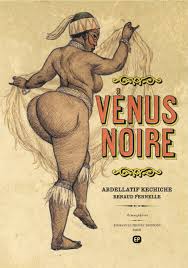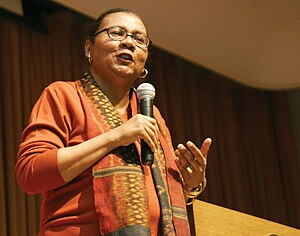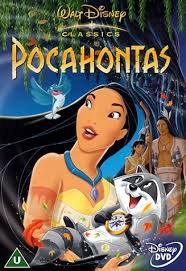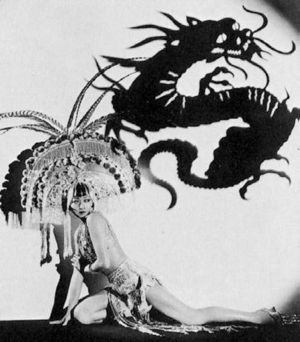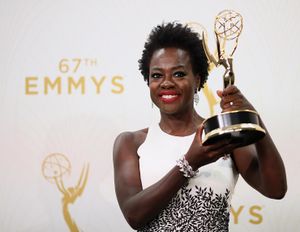Minority Women in Pop Culture and Media
In dominant and mainstream Western media, there is an overwhelming whitewashing that establishes the white, able-bodied, and middle upper class woman as representative of the female population. While whiteness is privileged, many groups of minority women face an erasure that pigeonholes them into limiting and hackneyed clichés about their ethnicity and identity. Rather than portraying three-dimension and well-rounded representations of African American, Asian American, and Aboriginal women, Western Media consistently falls back on certain demeaning and restrictive stereotypes.
African American Women
African American women are depicted in popular culture and media as sexually deviant, animalistic and savage. Their sexuality is often linked with a forbidden sense of allure as they represent the unrestrained and sexually voracious “Other” in relation to the pure, angelic and virtuous white woman. Depictions of African American women can be traced back to the European fascination surrounding the Sarah Bartmann exhibit in 1810. Sarah Bartmann was a South African woman who became the centre of an attraction in Europe under the alias of The Hottentot Venus. Bartmann’s body was put on display for white European citizens to pay to examine for its deviance and abnormality. This exhibit’s “exploitation of black female bodies” placed the African American woman’s racialized body as an object for the western gaze to marvel over.[1] This exhibit cemented the perception of African American women and their sexuality as the excess of exoticism and deviance that persists in current Western popular culture and media.
In the music industry, the feminism of African American women is often questioned, contrary to the one expressed by white women. This is what some call the double-standard in feminism. American author, feminist, and activist bell hooks mentioned that in the 10th chapter of her book "Feminism is for Everybody", Race and Gender. [2] On one hand, popstars such as Madonna and Lady GaGa are applauded for their revealing outfits and labelled feminists - even if they reject the terminology - because of how they embrace their body and sexuality. On the other hand, African American singers such as Beyoncé do the exact same thing but are deemed too sexy and provocative by the critics. In an article published in Vancouver Observer, Bianca Pencz called Beyoncé's feminism a Fauxminism.[3] She claims there is a contradiction between Beyoncé feminist-oriented lyrics and her sexually suggestive choreographies. In the article, Beyoncé is accused of portraying herself as a sexualized object created to satisfy male audience. This raises the issue of intersectionality in feminism. In fact, gender and sex interplay with race and class. Journalist Tamara Winfrey Harris from "Bitch Magazine" said that “criticism of the pop singer's booty shaking reflects our society's discomfort with black women and their bodies”.[4] The case of Beyoncé is particularly interested because she has accomplished many things that could easily be related to the feminist movement: she has an all-female band, she promotes gender equality (GQ's interview, February 2013 issue), she has written many feminist-oriented songs ("Independent Women" (2001), "My, Myself, and I" (2003)) yet she it still heavily criticised by many feminists. In her works, Caribbean-American author and feminist Audre Lorde explains how, as a black woman, she was discriminated within the movement because of her colour.[5]
Aboriginal Women
The two most overused stereotypes to characterize Aboriginal women in Western popular culture and media are the "Indian Princess" and the "Squaw".
Indian Princess
The Indian Princess persona depicts the aboriginal woman as "angelic and chaste" and acknowledging of the superiority of the white male settler. Often, the Indian Princess is willing to risk everything and turn her back on her people in order to help the white man. Through her obedience, virtue, and beauty she is "everything Europeans...loved about the New World". Although she is represented favourably, her identity only exists through her value to the white man through a Eurocentric lens. [6]
Squaw
The Squaw, on the other hand, exists on the opposing persona of the Aboriginal female dichotomy. She is portrayed as dirty, untrustworthy, and mischievous. She lacks the innocence and virtue of the Indian Princess persona and is perceived as completely debased and unworthy of respect. Her persona is met with a disgust and sub-human level of degradation.
Asian American Women
Depictions of Asian American women in mainstream popular culture and media are strictly divided into a neat binary that places them either as the Lotus Blossom/Geisha figure or the Dragon Lady figure. The Lotus Blossom/Geisha Asian woman is unthreatening, passive, and the ultimate delicate Asian flower. She is shy and represents a “passive figure who exists to serve men."[7] The opposing side of this binary is The Dragon Lady figure. The Dragon Lady represents aggressive and exotic promiscuity that is associated with “prostitutes…[or] devious madames."[8] Aside from these two stereotypical portrayals, Asian American women fail to find a space to exist within 21st century popular culture and media. Asian American actresses are few and far between, and are often limited to roles that are tainted with racist and demeaning undertones of being the sexually exotic “Other”.
Model Minority Stereotype
Asian American women, and Asian people in general, also fall victim to the Model Minority Stereotype in many mainstream portrayals. The Model Minority stereotype depicts Asian Americans as a minority group that represents the "ideal" minority due to their overall success and prosperity and lack of struggles compared to other minority groups, where their achievements are often downplayed and attributed to their ethnicity. However, this stereotype can have many "negative consequences for Asian Americans" by providing a "homogenization" of Asian Americans and erasure of the struggles and obstacles that they face as an underrepresented group. One example can be found on the popular Disney channel show The Suite Life of Zack and Cody in an episode where Cody's asian girlfriend, Barbara, explains that she even takes "A.P. Lunch", playing on the model minority stereotype of the Asian as nerdy and and excessively studious.[9]
Implications for Minority Women
Marci Littlefield, in her article "The Media as a System of Racialization" notes that "these sexually insatiable images are detrimental for the [minority] woman because they have a life of their own and take shape and meaning to viewers of these images. Although images alone cannot create behaviour, they can certainly inform behaviour (which is essentially what happened during reconstruction) and become the fabric of an American way of life."[10] This implies that the way in which minority women are portrayed in popular culture and the media has an impact on how minority women are viewed and treated in our world today.
Implications for Feminism
This whitewashing portrayal of women in mainstream Western popular culture and media contributes to a white washed feminist movement. Rather than represent a voice for the concerns and struggles of women of all minorities, this white feminism prioritizes the experiences of the middle class, able-bodied white woman as representative of the experiences of all women. However, there is literature that suggests White feminists have begun to understand and acknowledge the way in which growing up in a racist society can inevitably structure one's attitudes towards different races, and how the concept of White privilege thrived from this and personally benefitted them [11]
Essentialism
Essentialism is defined as "the view that, for any specific entity (such as an animal, a group of people, a physical object, a concept), there is a set of attributes which are necessary to its identity and function". By failing to acknowledge the intersections of feminism with other oppressive structures like race, class, status, and sexuality, the movement contributes to the erasure of many of the women it seeks to benefit. This erasure creates a divide and marginalizes groups of minority women like African Americans, Asians, and Aboriginals who fail to be represented in the supposed movement of gender equality for all. In Western society, this concept is found in the work of Aristotle and Plato. Platonic idealism is a theory of how "all known things and concepts have an essential reality behind them", such as a notion or configuration. Essentialism is high controversial. In gender studies, essentialism is crucial in the sense that the development of scientific theories have led to the construction of different classifications for different races. Essentialism also describes the basic theory that men and women are essentially different.
Positive Portrayals in Recent Pop Culture and Media
Viola Davis is an African American actress that has earned widespread praise and critical acclaim for her roles in films like The Help and Doubt. Viola Davis represents a minority presence in popular culture and mainstream film that rejects the hypersexualized and savage stereotype of the African American woman. Her roles triumph strength, independence, and reject the objectifying gaze that is often associated with African American minority women's bodies in the media. She has also been praised for speaking out on the lack of opportunity and representation of African American representation in blockbuster films, stating in her 2015 Emmy's speech, "“The only thing that separates women of color from everyone else is opportunity...you cannot win an Emmy for roles that are simply not there."[12]
References
- ↑ Henderson, Carol. “AKA: Sarah Baartman, The Hottentot Venus, and Black Women’s Identity”. Women’s Studies 43:7 (2014) Web. 15 Nov 2015.
- ↑ hooks, bell, "Feminism is for Everybody". Passionate Politics (2000) (ISBN 0-89608-629-1).
- ↑ Pencz, Bianca (April 26, 2012). "Beyonce: Feminist Or Fauxminist?". Vancouver Observer. Retrieved 2015-12-04.
- ↑ Winfrey Harris, Tamara (May 22, 2013)."Actually, Beyoncé is a feminist". Bitch Magazine. Retrieved 2015-12-04.
- ↑ "Interview with Audre Lorde," in Against Sadomasochism: A Radical Feminist Analysis, ed. Robin Ruth Linden (East Palo Alto, Calif. : Frog in the Well, 1982.), pp. 66–71 ISBN 0-960-36283-5 OCLC 7877113.
- ↑ Hay, Jody. “Native American Women in Children’s Literature.” Proquest, UMI Dissertations Publishing, 2002.
- ↑ Fung, Richard. “Looking For My Penis: The Eroticized in Gay Porn.” Http://www.richardfung.ca/index.php?/articles/looking-for-my-penis-1991/.N.p., 1991. Web. 15 Mar 2015.
- ↑ Lee, JeeYeun. (1996). Why Suzie Wong Is Not a Lesbian: Asian and Asian American lesbian and Bisexual Women and Femme/Butch/Gender Identities. B. Beemyn, & M. Eliason (Eds.), Queer Studies (pp. 115-132). New York: New York University Press.
- ↑ McClure, Stephanie, and Cherise Harris. Thousand Oaks: SAGE Publications, 2015. Print.
- ↑ Littlefield, Marci B. "The Media as a System of Racialization: Exploring Images of African American Women and the New Racism." American Behavioral Scientist 51.5 (2008): 675-85. Web.
- ↑ Thomlinson, Natalie (2012) "The Colour of Feminism: White Feminists and Race in the Women's Liberation Movement" The Journal of the Historical Association, 97 (327), 453-475. doi: 10.1111/j.1468-229X.2012.00559.x
- ↑ Heyman, Jessie “Viola Davis Gave the Most Powerful Emmy Awards Acceptance Speech of All Time” VOGUE. N.p., 20 Sept 2015. Web. 16 Nov 2015
